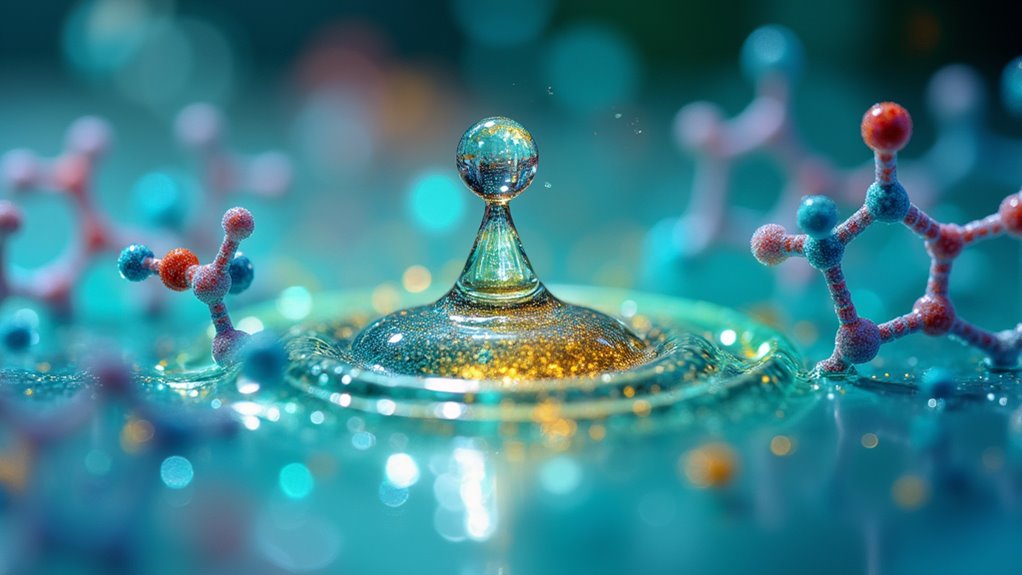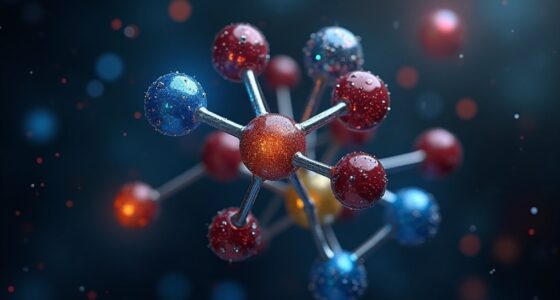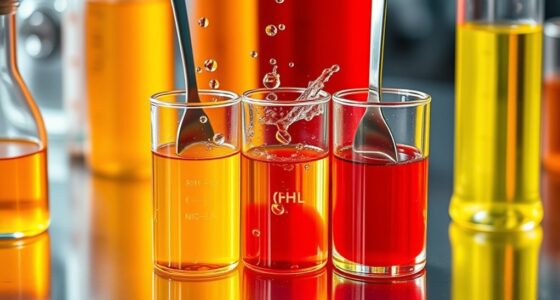Enzymes speed up chemical reactions by lowering the activation energy needed for reactants to turn into products. They achieve this through their active sites, which uniquely fit substrates and stabilize transition states, making reactions happen faster. Enzymes also bring molecules into the right position and shape, reducing energy barriers. By understanding how enzymes work, you’ll discover the key strategies behind their efficiency and the many factors that influence their activity.
Key Takeaways
- Enzymes lower activation energy by stabilizing the transition state of reactions.
- They bring substrates into close proximity and proper orientation to facilitate reactions.
- Enzymes induce conformational changes that shape substrates into transition state-like forms.
- They stabilize charged or unstable intermediates through electrostatic interactions.
- Enzymes utilize covalent and non-covalent interactions to accelerate reaction rates significantly.
The Role of the Active Site in Enzyme Function
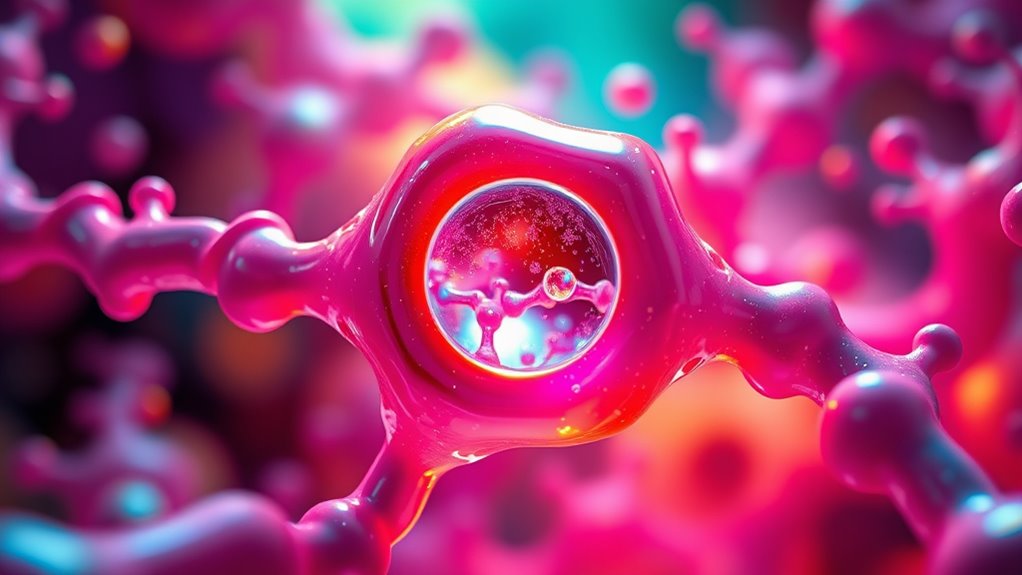
The active site of an enzyme is crucial because it directly interacts with the substrate to facilitate a chemical reaction. This specific region has a unique shape that fits the substrate like a key in a lock. When the substrate binds, it forms an enzyme-substrate complex, which stabilizes the reaction and lowers the energy needed to break or form bonds. The shape and chemical environment of the active site ensure that only particular substrates can bind, providing enzyme specificity. This precise interaction allows the enzyme to position the substrate correctly, promoting the reaction. Without the active site’s specialized structure, the enzyme couldn’t effectively recognize or interact with its substrate, making it essential for the enzyme’s role in speeding up reactions efficiently.
How Enzymes Lower Activation Energy

Enzymes speed up chemical reactions by lowering the energy barrier that must be overcome for the reaction to proceed. They do this through several mechanisms. First, the induced fit model changes the substrate’s bond configuration to resemble the transition state, making it easier to reach. They also bring substrates into close proximity and proper orientation, reducing entropy. Weak interactions, like hydrogen bonds and van der Waals forces, stabilize the transition state, releasing binding energy that directly lowers the activation energy. Electrostatic stabilization counteracts transition state charges, while the enzyme’s geometric strain distorts substrate bonds toward the transition state. Additionally, covalent catalysis creates intermediates, and localized desolvation amplifies electrostatic effects. These combined actions effectively make it easier for the reaction to occur, vastly increasing its speed.
Key Mechanisms Behind Enzyme Catalysis
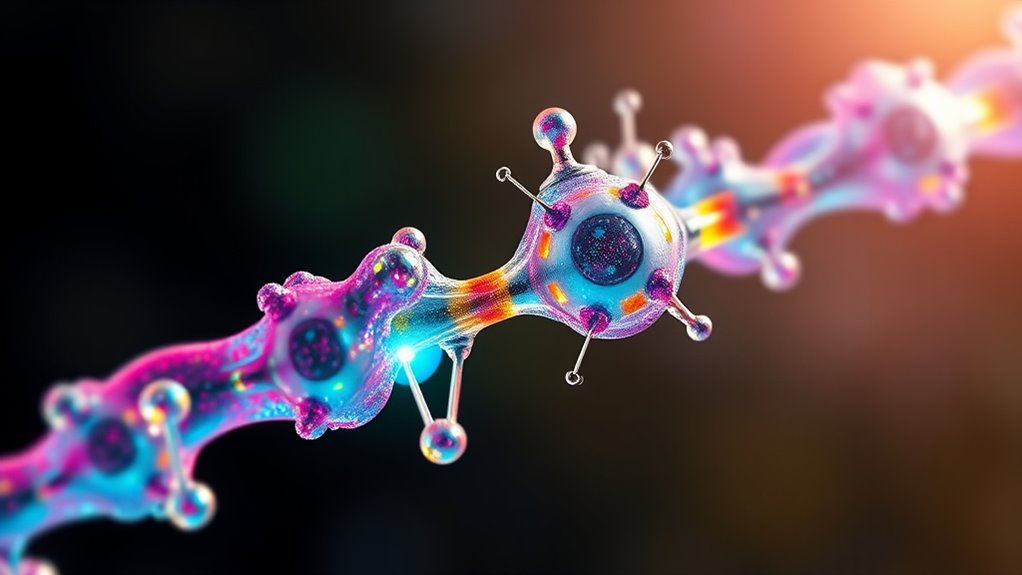
Understanding how enzymes accelerate reactions involves examining their key catalytic mechanisms. You should know that enzymes bind substrates at active sites through noncovalent interactions like hydrogen bonds, ionic bonds, and hydrophobic effects. They often induce conformational changes, shaping substrates to resemble the transition state, which lowers energy barriers. Enzymes also stabilize transition states directly, making reactions easier. The geometry of the catalytic site is crucial, ensuring precise substrate recognition and positioning. Different mechanisms, such as covalent catalysis, acid-base catalysis, electrostatic interactions, and strain distortion, work together to speed up reactions. Enzymes stabilize intermediates and optimize substrate orientation, dramatically increasing reaction rates. Additionally, retail hours today can impact when certain enzyme-related supplies or services are accessible, emphasizing the importance of timing in enzyme applications. Recent advancements in AI security highlight the importance of safeguarding enzyme technologies against potential cyber threats, ensuring their safe application across industries. Furthermore, ongoing research into enzyme dynamics provides deeper insight into how enzymes adapt their structures during catalysis, which can inform the development of novel inhibitors or industrial catalysts. Understanding enzyme mechanisms at a molecular level is essential for designing effective drugs and biotechnological solutions. Moreover, the structural features of enzymes are carefully evolved to optimize their catalytic efficiency and specificity.
Factors That Influence Enzyme Activity

Multiple factors influence enzyme activity, and their effects can vary depending on conditions. When enzyme concentration increases, the reaction rate rises proportionally if substrate is abundant. However, at high substrate levels, saturation occurs, and all active sites become occupied, limiting further speed increases. Increasing enzyme availability accelerates product formation until saturation. Substrate concentration also impacts activity; low levels produce a linear increase, but beyond a certain point, the rate plateaus at Vmax due to enzyme saturation. Temperature and pH are critical as well; each enzyme has an optimal range where activity peaks. Temperatures too high cause denaturation, while low temperatures slow molecular collisions. Extreme pH levels alter enzyme charge states, disrupting function. Ionic environment influences stability and substrate binding, with salts and metal cofactors playing vital roles. Additionally, the presence of cofactors and coenzymes can significantly enhance enzyme efficiency and activity. Furthermore, the environmental conditions can affect enzyme conformation, and thus, their catalytic capabilities. Changes in substrate affinity can also impact how efficiently an enzyme binds to its substrate under different circumstances. Moreover, the availability of enzyme inhibitors can decrease activity by blocking active sites or altering enzyme structure.
Practical Uses and Significance of Enzymes

Practical uses of enzymes span across many industries, significantly enhancing processes and product quality. In food, enzymes improve texture, shelf life, and flavor in baking and dairy products. In agriculture and chemicals, they reduce processing time and replace harmful chemicals, supporting sustainability. Enzymes also play a vital role in biofuel production by converting biomass into renewable energy, aligning with eco-friendly goals. The enzymes market is expanding rapidly, expected to reach USD 11.2 billion by 2029, driven by demand in food and biofuel sectors. Advances in biotechnology and protein engineering have expanded enzyme applications, making them more efficient and versatile. Their use promotes cleaner, natural ingredients, meeting consumer preferences for organic products. Additionally, innovations in enzyme development are enabling region-specific applications, further broadening their industrial impact. The increasing adoption of biotechnology advancements is making enzyme processes more cost-effective and environmentally friendly. Moreover, the development of green enzyme technologies is helping industries reduce their ecological footprint while optimizing production. Enzyme stability under various industrial conditions is continuously being improved to enhance their performance and application scope. Furthermore, research into enzyme immobilization techniques is increasing enzyme reusability and efficiency in industrial processes. Overall, enzymes are crucial for creating sustainable, efficient, and high-quality industrial processes.
Frequently Asked Questions
How Do Enzymes Recognize Their Specific Substrates?
You can see that enzymes recognize their specific substrates through their active sites, which are shaped to fit particular molecular structures. They adapt structurally to bind substrates precisely, often using ligand binding, metal ions, and flexible conformations. These interactions ensure proper alignment for catalysis. By discriminating between similar molecules, enzymes achieve specificity, while some flexibility allows them to accommodate diverse substrates, highlighting the balance between precision and adaptability in enzyme recognition.
Can Enzymes Work Effectively Outside the Body?
You might wonder if enzymes can work effectively outside the body. They can, but only under carefully controlled conditions like optimal pH and temperature. Industrial uses often require stabilization methods, such as additives or immobilization, to preserve activity. Extreme conditions, like high heat or unsuitable pH, can denature enzymes and stop their function. With proper adaptation strategies, enzymes can perform efficiently in various external applications.
What Causes Enzyme Inhibition in Biological Systems?
Did you know enzymes can be inhibited by over 200 different molecules in biological systems? You see, inhibition occurs when substances like covalent inhibitors permanently disable enzymes, or reversible competitors block active sites temporarily. Allosteric regulators bind elsewhere, changing enzyme shape and activity. Protease inhibitors, for example, prevent premature enzyme action. These mechanisms ensure that enzyme activity stays tightly controlled, preventing unwanted reactions and maintaining cellular balance.
How Do Temperature Changes Affect Enzyme Structure?
You should know that temperature changes can significantly impact enzyme structure. When temperature rises, your enzyme’s shape may shift due to conformational changes, which can either increase or decrease activity. If it gets too hot, the enzyme might denature, losing its functional shape entirely. Cooler temperatures can make the enzyme less flexible, reducing its ability to bind substrates effectively. Overall, maintaining an optimal temperature is crucial for enzyme stability and function.
Are Enzymes Reusable After a Reaction?
You’re wondering if enzymes can be reused after a reaction. The answer is yes; enzymes are reusable because they remain chemically unchanged after catalysis. They bind to substrates, facilitate reactions, then release unchanged, allowing them to catalyze multiple reactions. Industrial practices often immobilize enzymes to enhance reuse, which reduces costs. However, factors like denaturation, inhibitors, and environmental conditions can limit their reusability, typically allowing 5 to 100 cycles before replacement.
Conclusion
Understanding how enzymes speed up reactions helps you see their vital role in life processes. While it might seem complex, remember that enzymes act like biological catalysts, making reactions more efficient without being consumed. Don’t worry if some reactions seem slow without enzymes—they’re simply waiting for the right catalyst. By appreciating these natural helpers, you can better understand the delicate balance that keeps organisms functioning smoothly every day.
